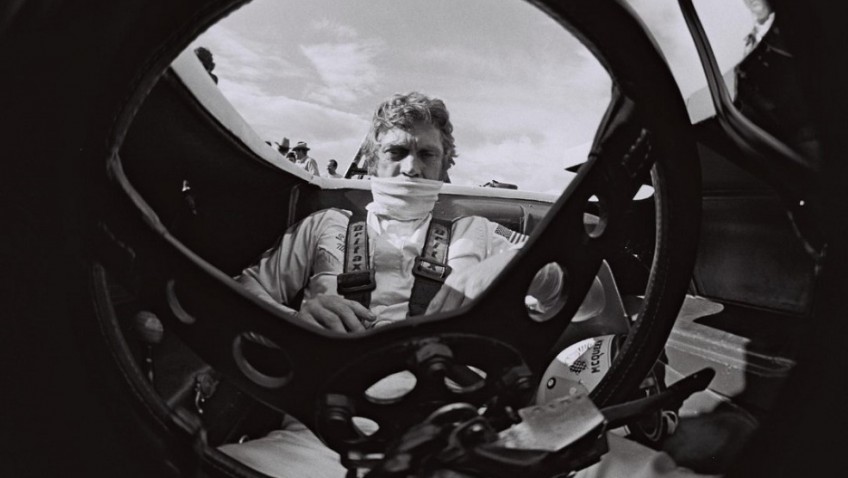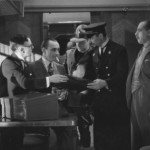Joyce Glasser reviews Steve McQueen: The Man & Le Mans
A definite must for fans of Steve McQueen and car racing, Steve McQueen: The Man & Le Mans will also be of interest to anyone interested in how films are made and how they unravel. Directors John McKenna and Gabriel Clarke chronicle, in sometimes redundant detail, the fascinating story of the making of the film Le Mans and leave us with a cross between a post-mortem and a cautionary tale. The film Le Mans began in 1969 as a vanity project executive produced and back-seat directed by its star, Steve McQueen, at the top of his career. If 44 years seems like a long time to wait for a documentary about a film that flopped at the Box Office in 1971, it is because a million feet of lost contemporaneous footage had been shot and presumed lost until recently. McKenna and Clarke make good use of the footage which is supplemented with fascinating interviews in Steve McQueen: The Man & Le Mans.
‘What was happening when we were shooting this movie should happen to no man’, begins Le Mans production executive Bob Rosen, one of several ‘players’ and cast members interviewed for the documentary. The man it happened to is Steve McQueen, the highest paid actor in Hollywood after The Magnificent Seven, The Great Escape, The Thomas Crown Affair and Bullitt in 1968. If McQueen was known as ‘The King of Cool’, that sobriquet is related to his passion for racing motorcycles and cars, a passion memorably present in The Great Escape, and in the stupendous, 10-minute car chase in Bullitt.
It was only the ‘key man clause’ in insurance policies that had precluded McQueen from actually jumping the fence in The Great Escape (he did the rest of the rest riding) or doing all of the stunt driving in Bullitt and Le Mans. For McQueen was good enough to have turned pro. In 1970, he (and team-mate Peter Revson) finished second by only 23 seconds to Mario Andretti’s team in the 12 Hours of Sebring race. They might have won but McQueen was handicapped with a caste on his leg from a motorcycle accident. McQueen was furious when Grand Prix, starring James Garner, pipped an earlier racing film project to the post, and was determined to kick start his new production empire with Le Mans.
By 1969, McQueen had all the elements but one in place. The finance; script writer Alan Trustman (The Thomas Crown Affair and Bullitt); Director John Sturges (The Magnificent Seven and The Great Escape) and cast of professional race car drivers, some of whom would play characters in the film were all present. What he did not have was a script. McQueen and Trustman argued over McQueen’s insistence that his character be a loser, and Trustman refused to rewrite the script. Trustman, now 84, tells us that after his public rift with McQueen, ‘the phones stopped ringing’ and he never wrote a script again.
When McQueen heard about the murder of his close friend Jay Sebring at Sharon Tate’s house (apparently McQueen had been invited) and learned that he was on Charles Manson’s kill list, he started carrying a gun and became paranoid. His 13-year marriage to actress Neile Adams was also srained when she showed up on set. She had put up with his infidelity for years, but during the production she admitted having an affair of her own (they divorced the year after the film was released, in 1972).
The interviews with Adams, and those with Swedish actress Louise Edlind, liven up the film, but the interviews with McQueen’s son Chad and stunt driver David Piper, are the most moving. Chad, now 54, an actor/producer and race car entrepreneur, became addicted to cars as a boy on the set of Le Mans and his injuries (he nearly died in 2006) are clearly visible. Piper’s left was amputated below the knee.
When Trustman was replaced with Bullitt co-writer Harry Kleiner, and Sturges, who quit in disgust at the mismanagement, was replaced with Lee H Katzin, the direction of the film was still unclear, and so Katzin had one race scene shot twice. On the second run, Piper’s car was totalled and he was lucky to be alive. The film only went ahead when a new finance package was put in place with McQueen’s trusted friend produce Bob Relyea out of the picture and McQueen’s role reduced to that of his character in the film, Mike Delaney.
McQueen intended the film to provide a visceral, authentic experience, and built a min-studio in Le Mans as the race figures in the film. Special affects were out, and real driving was in. The plot and dialogue were kept to a minimum as the focus was clearly on the driving. Not, perhaps what audiences wanted or expected in 1971. But what is interesting is that McQueen’s vision is not all that different from director Asif Kapadia’s in his Academy Award-winning documentary Senna, only in reverse. McQueen wanted to shoot a live action drama like a motor racing documentary, while Kapadia moulded a powerful character study and moving story out of hours of edited archive footage.
The aim of both was to make it real, but you still need a story.




